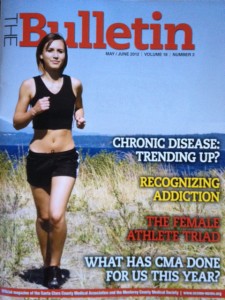I know this is off base for a plastic surgeon, but as a female plastic surgeon in the Bay Area, I see many women come through my office. Northern California is a haven for the incredibly active, athletic woman. And when fit, being thin tends to go with it. But when is it a problem? This is from an article published in the Santa Clara Valley Medical Association Journal, written by Drs Golden and Carlson. 
So what is the triad?
1. low energy availability (“the negative balance between energy intake and energy output.”)
2. menstrual dysfunction (luteal phase defects, irregular periods, no periods.)
3. reduced bone mineral density. (due to increased bone resorption and reduced bone formation, leading to increased fracture risk later in life.”)
They state “amenorrhea (no periods) is not a normal consequence of exercise, and should be considered a red flag for more extensive screening.” Other red flags are stress factures and low impact fractures. If at risk, they should have a caloric evaluation, optimize calcium and vitamin D supplements, and refer to an eating disorder clinic if appropriate.
Hormone levels (FSH, LH, and estradiol) can be followed. The estradiol levels are important, and when normal, menses will resume.
Bone mass improves with normal estradiol, and can improve with weight bearing activities.
So?
This is food for thought (pun intended) for my patients.
I see women in my office frequently who are very dedicated to exercise and very thin. For my surgical patients, could low estrogen level affect anything? Are you menstruating? Do you work out incessantly? Are you eating enough calories to balance the athletic output you are doing? We think there is a link between estrogen and your ability to heal. See a study on it here and here. These studies seem to indicate higher infection rates and wound issues when women do not have adequate estrogen. These studies were done on larger procedures (breast cancer reconstruction, breast reduction). Also, if you are relatively undernourished, may you lack the nutritional reserves necessary to heal well from a big surgery?
For more information on the triad, see the Dr’s website, at www.edrcsv.org. They run the Lucile Packard Children’s Hospital Comprehensive Eating Disorders Program at Stanford. I did not include their program title purposefully at the beginning of the blog, as I think many women who may have this disorder eat- they would not consider themselves anorexic or bulemic. But the issue is the energy intake (food) is less than their energy output (exercise).
